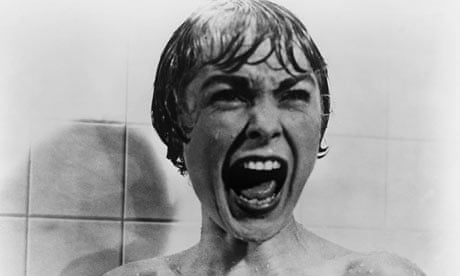There is often fear, danger, suspense and action in cinema, but horror is something extra. It's the challenge that asks: "Do you think you can actually look at this, without running out of the dark screaming?" At first in film history, horror was fantasy and fanciful: it was Dracula, or Nosferatu, the spectre of endless night from which you could never escape. Or it might be the Frankenstein monster, the Wolf Man, or Mr Hyde. All of those characters had their roots in folklore and literature, to say nothing of the psychology of nightmares. But in the 50s, horror began to be domesticated. Henri-Georges Clouzot's unbearably frightening film Les Diaboliques (1955) suggested the monster was just the man you were married to (previously a topic for comedy). That film had a huge influence on Alfred Hitchcock, who had a new trick for horror up his magician's sleeve.
Psycho starts out as a kind of road picture, or the study of a pretty, decent woman under stress. Marion Crane (Janet Leigh) drives for two days and finds herself lost in the rain when she finally sees the motel sign: "Vacancies". What a relief. And there's this very sympathetic young man, Norman, in charge of the place, the most tender, thoughtful person she's met so far.
The setup was cruel, but this was Hitchcock. Something is going to happen. Here's Marion, taking off her clothes again. She's made up her mind. She's going to go back to Phoenix to return the $40,000 she stole. So it's going to be OK – except that the movie is only 45 minutes old. What else can happen?
"What else?" occupied a full week before Christmas 1959 as Hitchcock shot the shower scene – the most radical, horrific assault on us that the movies had ever dared. Could we watch? It was part of Hitchcock's provocative primness that, after this meticulous outrage, he declared with wide eyes and wider vowels that you couldn't actually see a knife-point piercing flesh. Connoisseurs who can watch it frame by frame say that's a white lie, but who cares? The point of the scene is the onslaught on sensibility and the weird mixture of feelings left in us – for we are being attacked, but we are the attacker too. What ensures that ambivalence is the very deliberate way in which for 40 minutes the movie has stripped, grilled and stared at Marion until we want her and her flesh.
Of course, in the end, that is the most horrific thing of all – the tacit complicity is more disturbing than the hideous murder. And after Psycho, the knives were out, with chainsaws and the vast armoury of modern cold steel. Murder has become a sport which every amateur is prepared to practise in his or her head. The scene runs less than a minute, with every angle calculated and predesigned. The orgy had begun.
Watch it here: bit.ly/psychoshower
